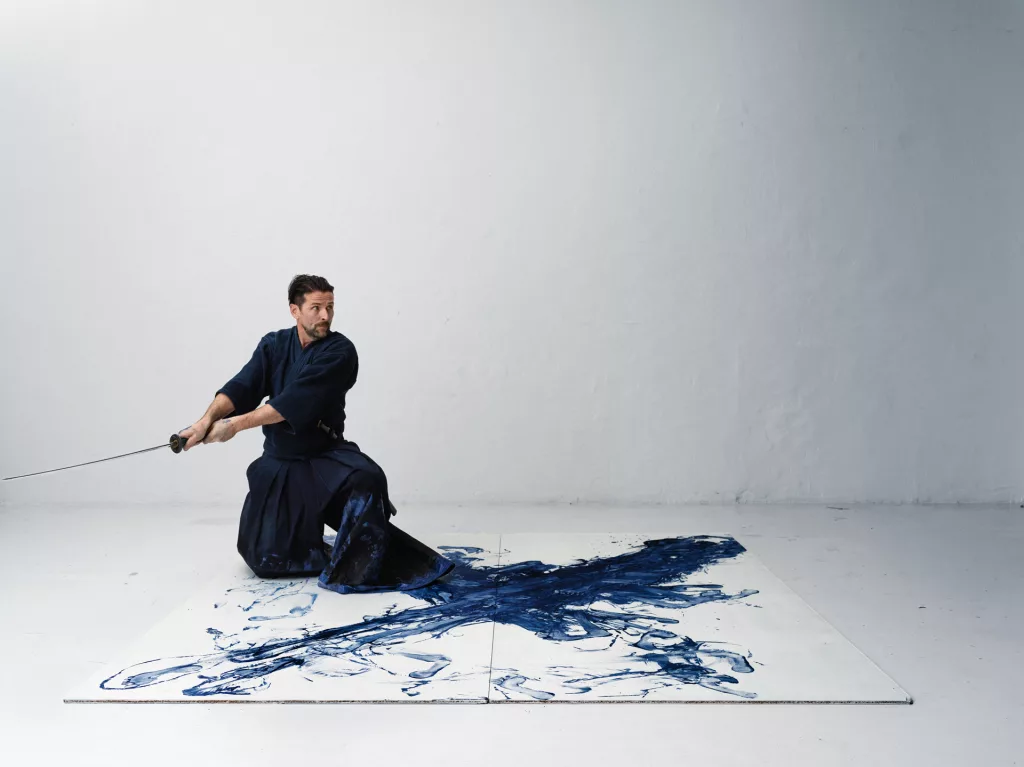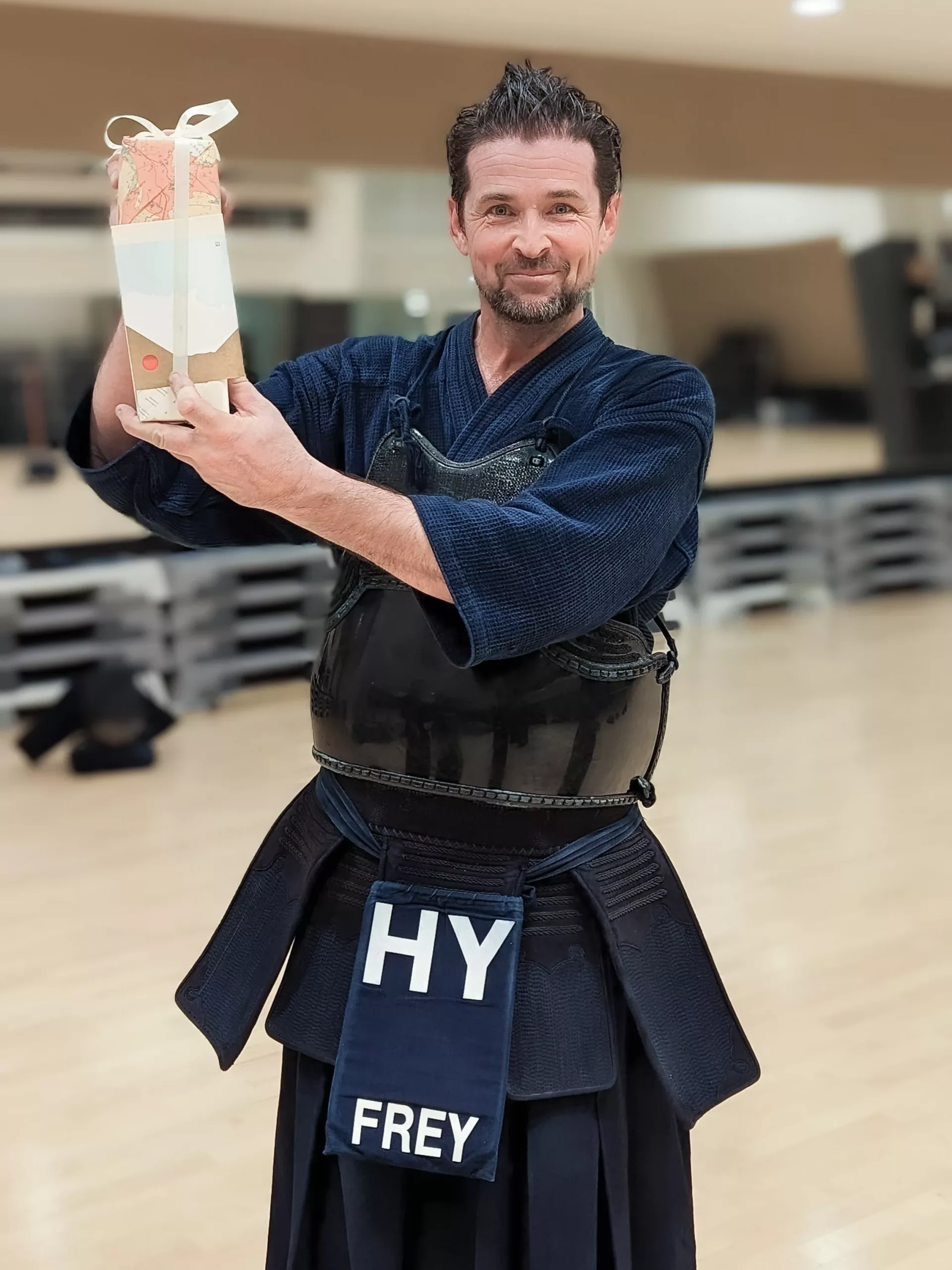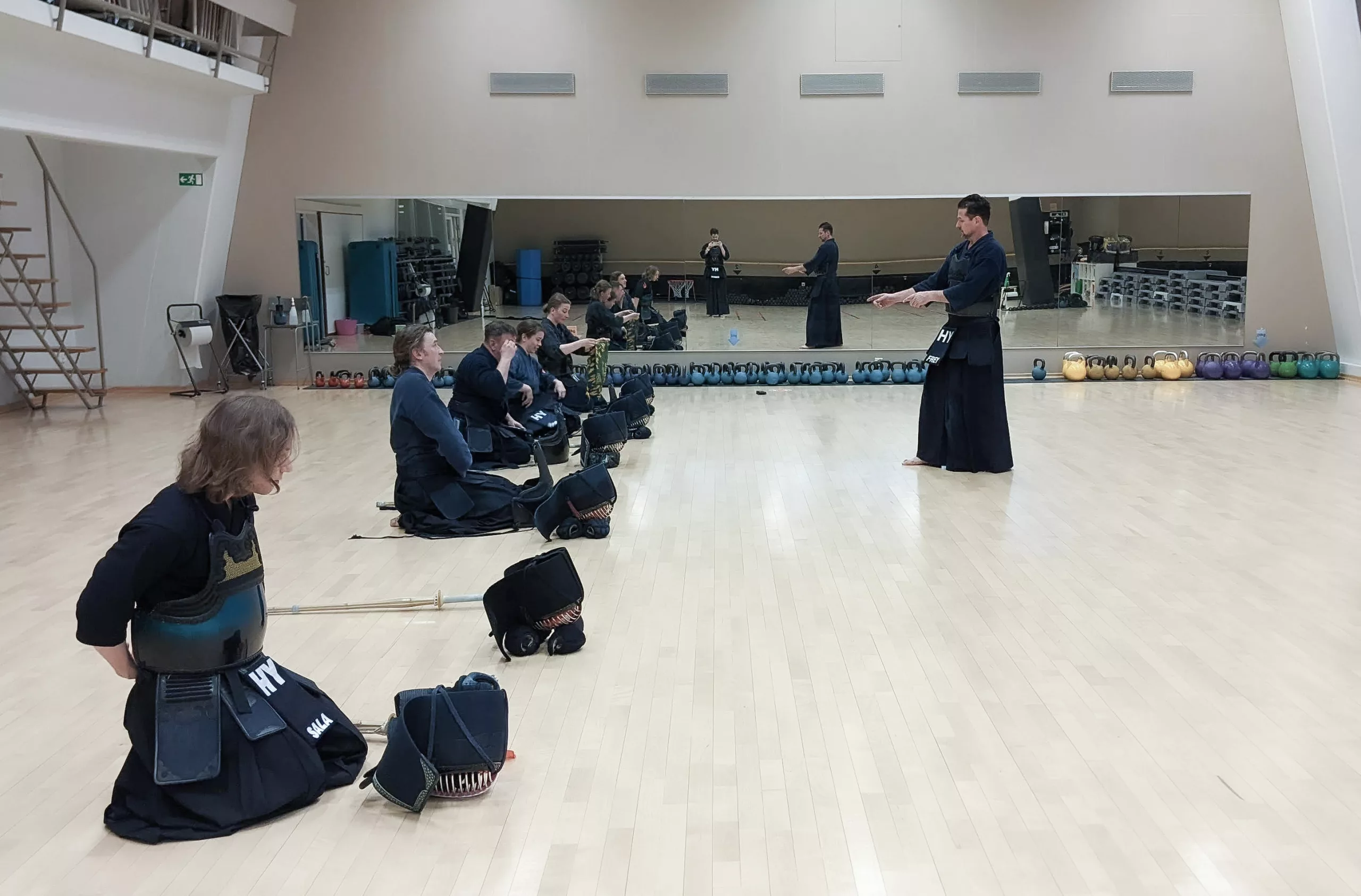The number of those who practice kendo outside of Japan on a regular basis has been increasing. This can also be told about those practitioners, senseis, and educators who try the hachidan shinsa – which is often referred to as the most difficult examination in the world. We are lucky in Finland to have the possibility of training with a number of 7th dan senseis,1 and we in Helsinki are even more lucky to regularly attend practices with them, and even welcome them to the practices of the University of Helsinki Kendo Club.
Markus Frey (7th dan, kyoshi) has been attending and teaching our Tuesday asageikos for years now. After countless “afterkeiko breakfast” discussions, we decided to do an interview with him and publish it here – for the benefit of all. Here is the first part of this interview, which was conducted by Merci Czimbalmos. Enjoy!

Markus Frey
Photo credits: Markus Frey.
_________________________________________
Merci Czimbalmos: Before talking about the hachidan shinsa, I would like to jump back a bit, and ask you about the nanadan. When and where have you done it and when did you try hachidan first?
__________
Markus Frey: I did my 7th in 2010 in Debrecen, in Hungary at the European Championships that time. I was not competing anymore, but I was the coach of the Finnish national team. That was my first attempt of seventh dan, and I managed to pass. And then, as you know, there is ten years between the seventh dan and hachidan. I was supposed to go to Kyoto in 2020 for my first attempt of hachidan, but then Covid-19 hit the world and everything was canceled. Then I had my first try postponed for two years, and I had my first attempt on November 2022, and then in 2023, last November was my second attempt.
__________
MC: I think when we think about or discuss the hachidan shinsa, we usually think of it as something very distant, or unachievable. How have you felt about it after passing nanadan? After having prepared for the nanadan, and having passed it, knowing that the next step is hachidan?
__________
MF: Yes, initially it felt like a dream to pass the hachidan test because so few succeed—mostly police or professional kendo teachers with years of dedicated practice. When you are for example in the tokuren2 you have keiko three times a day and competitions on many weekends. It prepares you for this “mental stress” which is enormous when you are taking the hachidan test. It is not possible to have these kind of circumstances in Europe. This is maybe one of the reasons why passing the 8th dan test also feels like an unreachable goal. Yet, there’s always a small piece of hope when you see others pass, which motivates even those of us training in Europe to continue striving. Preparing for my first attempt, I was holding on to this hope and encouragement from many senseis who urged, “You must try, you must go there!” I think my first attempt was more like gaining the experience and navigating the system. There is around 1000 people taking part, and you are puzzled with registering, getting your number, understanding which shiaijo you’re on, so there is a lot of distraction. I think it’s the same for the Japanese as well. I think that is also part of why not many people pass on the first attempt. On my first attempt in 2022 I didn’t pass the first round of the test. When I tried for the second time in last November 2023 I was able to push through to the second round and have two more jigeikos with the last 10 percent of the candidates. After that experience my mindset shifted dramatically. Earlier I thought I might never get hachidan, but now I really know it is possible.
__________
MC: I have a couple of follow up questions connected to this before asking about the preparation. I did my yondan in Japan. What you mentioned about your experience is also familar for me. Getting the numbers doing the “bureaucartic” things. I felt at the time, that to an extent, it’s a really different environment and a really different system in many ways than from what we do in Europe. It’s the same system, but it’s still feels slightly different. What came to my mind is that do the say, “non-Japanese” nanadans, or more like the nanadans who do not regularly train in Japan discuss these things in between themselves? For example, those who tried hachidan and those who are preparing for it: have you had these conversations with them before, either the first or the second attempt on these practical things that no one thinks about, but they have an impact?
__________
MF: Not really. I got my information by asking the Japanese hachidan senseis. There hasn’t been, I wouldn’t say none, but I have received information on these practical things only a few times. My main source of information was that I spent two days in the audience in 2019 watching the hachidan shinsa, taking notes and just marking things like what time does it start, when does the second round start, things like that.
__________
MC: Right. So, you observed how it goes, before the attempt itself. That then leads me to other matters on the “preparation.” How was it like for you to prepare in this Finnish, or in the European environment? Knowing, that we have quite a few nanadans and rokudans in Finland nowadays.
__________
MF: Well, in Japan there is a chance to practice with the hachidan regularly, on a weekly basis at least, which means that you have the possibility to get more guidance. The problem with the European environment is that you need to have the experience of a real professional player, who is your age, who has the speed and the strength, and those things. I think this is the biggest difference between Europe and preparing in Europe and preparing in Japan. I mean, you just try to do a lot of thinking about what is necessary. You try to use all the opportunities that you have and get to keiko with hachidan senseis when they are visiting Europe. Actually, since I knew that there is not that many opportunities to practice kendo on a level that I would have wanted, I just decided that, I will try to prepare as good as I can and also doing something other things that support my preparation. I think the biggest difference between my first attempt and the second attempt and the success on the second attempt, is of course the experience in kendo, but I also did a lot of like running exercises, and image training just by myself, to compensate the fact that I was preparing in Europe and maybe didn’t have the chances that I would have had if I’d been in Japan. And then of course, using all the videos and analyzing my kendo and things like that. They are very helpful for preparing.
__________
MC: Now that you mentioned these different exercises, I cannot not ask about the elephant in the room, which is Covid-19. How did it effect your preparation? Besides the obvious, perhaps. And more than that, how did that feel?
__________
MF: At some points it was frustrating. My feeling was you see the people who pass the hachidan: most of them are around their 50s or even a bit younger. Of course, there are also older people who pass it, but only a few. I had this kind of “time is passing by” feeling, and I knew that there’s no chance to take part in the grading, and we did not even know when will the Covid-situation be over, so it created frustration, and you kind of feel that the door is closing. You’re getting older. Your physical abilities are…I mean, you’re getting slower, weaker, so you’re kind of like fighting, and trying to fight back the evident changes in your body, still hoping that you will be in a good shape and have the chances to go to the the exam. So, it was testing the motivation as well. I think there’s always a silver lining in things, because during the Covid and we did the 1000 suburis a day. People really needed figure out why are they doing kendo. At least I realized that hachidan is a dream, but it’s secondary to the actual practicing process of learning kendo, and enjoying the practice. I think this may sound lame, but the shinsa is secondary to the process of kendo. It’s molding your character and hopefully making you as a better person. I really see it like that. In that sense, the exam is a secondary goal: it could happen or then it couldn’t happen, but it doesn’t make you a bad person if you don’t succeed. The process itself, I mean of preparing for hachidan, it’s really enjoyable, I would say. Of course, it creates stress, it creates anxiety, you are restless. The preparation, it’s taking a long time. You’re, having this frustration that, “why don’t we just get over it so that I could relax.” But actually, to have such a big target builds your preparation and your daily practice: you have a clear goal, and then there is a purpose and meaning in your practice. It is important to just to have this in mind. Even during the Covid I have to make the best ouf ot the 1000 suburis, use them for my benefit, and adjust to the circumstances.
__________
MC: Do you think that the fact that you haven’t been able to do “regular” keiko as often as before, as intensely as before benefitted you on the long term, in a way that you perhaps did not foresee?
__________
MF: Yes, definitely. Going to the basics and just doing suburi….I think, that if we would have to choose things and do only a couple of things in order to have progress in kendo, I would choose suburi and jigeiko. These two things, because with suburi, you can really check yourself that you are doing everything correctly. And then, of course, during jigeiko, you have the other person, and then everything else, such as your seme and other things become visible. On the long run, I think that it was a bless also to just concentrate on suburi.
__________
MC: What about hints and advices you got, after the first attempt? What were they, if there were any, and how did you try to implement those?
__________
MF: Well, the first attempt was behind closed doors. I didn’t have it on video, so it was really hard to get any advice. Of course, I went to Japan I think ten days before the exam. There was a very good tachiai practice at Iwatate sensei’s dojo, in Shofuukan. There I got some really good advice. But the problem is with the advice that if you go there just before the exam and you get loads of information and advice, then you become very puzzled in a way. I was aware that this could happen, and I accepted the challenge and that I might get a little bit off balance with all the advice, but anyways, I tried to follow the advice because I found it very useful for my development. As a result during my first attempt, I clearly felt that I was too conscious of myself. I was paying too much attention to myself and avoiding mistakes, and I really couldn’t be 100% focused on my opponent. This is what happened, and this is the downside of getting instructions. But afterwards, I felt that they were good advice and good souvenirs to take back to Finland. Then I started to work on the advice that I got. After coming back to Finland, after the first attempt, the next possible chance for the next training would have been Kyoto in April ’23, but I felt that that there’s so many advice that I need to digest and work on. I realized that I need to study the information and the instructions that I got for a year. Then, I decided that, I will try next time in November ’23. You need to kind of adjust the instructions, and formulate them so they suit you, and that takes time.
__________
MC: Can you tell some of those instructions or suggestions that they gave you back then?
__________
MF: Yeah, yeah! Well, the first thing is my left hand. That was something that Iwatate sensei pointed out. My left hand, just before hitting, for some strange reason, moved to the left, and that ruined the strike. It was not a big movement, but it still happened. Then my hitting posture was not good: my body was not supporting the strike enough. This is why I did a lot of running exercises, quads, these kind of things, to have more power in my legs and in the core, just to make the posture when I strike better. Then the understanding of seme and hasuji, and the subtle things that you can do with your sword to manipulate the other, and to have a feeling of center, and then just like going forward quickly. I found these advices very useful. Another thing I was pointed out I stood up from sonkyo, I was always taking a step to the right. These kinds of things that are small and you don’t maybe notice them by yourself, so you need somebody from outside to tell about them. I wanted to get rid of all of those, not to give any kind of signal to my opponent and to really have just like a “standard procedure” when starting from sonkyo.
_________________
You got this far? Great! This is your “cliffhanger” then. We will continue in a separate post about Markus’ experiences with his second hachidan attempt, as well as with some of his advices for those, who are working to take an exam on lower levels in kendo. Stay tuned!
_________________

__________________________________________________
- Currently (04.2024) the following individuals hold 7th dan in kendo in Finland: Markus Frey (7.dan kyoshi), Mikko Salonen (7. dan, kyoshi), Kari Ruuhilahti (7.dan, renshi), Markus Lyyrtö (7.dan, renshi), Sakari Jokinen (7.dan, renshi) ↩︎
- Short for Jutsuka Tokubetsu Kunren (術科特別訓練). Eng.: Special Technique Training Department. Tokuren is a police squad in Japan. Their purpose is to promote and reinforce technical training within subjects such as kendo, judo, etc. to raise the overall level of health among police officers. Want to know more? Here are some links: https://weblog.tozando.com/tokuren-z-a-kendo-bogu-made-for-winners/
https://kenshi247.net/blog/2018/06/15/kendotokuren/ ↩︎


Leave a Reply